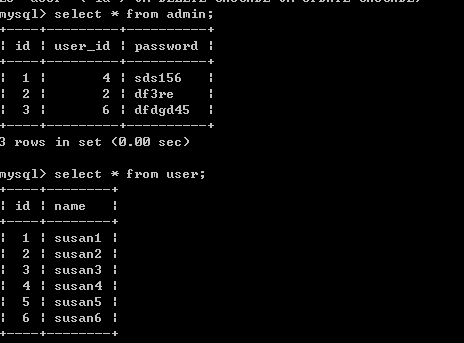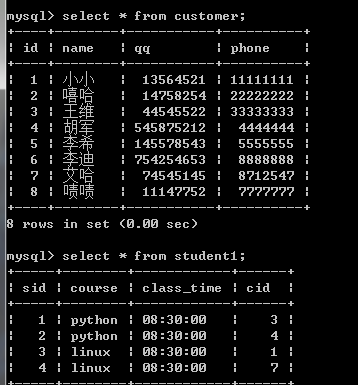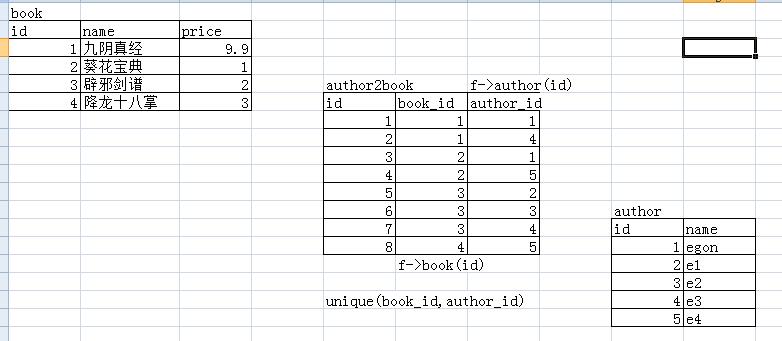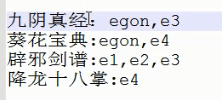資料庫之 表與表之間的關係
阿新 • • 發佈:2019-01-22
表1 foreign key 表2
則表1的多條記錄對應表2的一條記錄,即多對一
利用foreign key的原理我們可以製作兩張表的多對多,一對一關係
多對多:
表1的多條記錄可以對應表2的一條記錄
表2的多條記錄也可以對應表1的一條記錄
一對一:
表1的一條記錄唯一對應表2的一條記錄,反之亦然
分析時,我們先從按照上面的基本原理去套,然後再翻譯成真實的意義,就很好理解了
一、多對一或者一對多(左邊表的多條記錄對應右邊表的唯一一條記錄)
需要注意的:1.先建被關聯的表,保證被關聯表的欄位必須唯一。
2.在建立關聯表,關聯欄位一定保證是要有重複的。
其實上一篇部落格已經舉了一個多對一關係的小例子了,那我們在用另一個小例子來回顧一下。
這是一個書和出版社的一個例子,書要關聯出版社(多個書可以是一個出版社,一個出版社也可以有好多書)。
誰關聯誰就是誰要按照誰的標準。

書要關聯出版社 被關聯的表 create table press( id int primary key auto_increment, name char(20) ); 關聯的表 create table book( book_id int primary key auto_increment, book_name varchar(20), book_price int, press_id int, constraint Fk_pressid_id foreign key(press_id) references press(id) on delete cascade on update cascade ); 插記錄 insert into press(name) values('新華出版社'), ('海燕出版社'), ('擺渡出版社'), ('大眾出版社'); insert into book(book_name,book_price,press_id) values('Python爬蟲',100,1), ('Linux',80,1), ('作業系統',70,2), ('數學',50,2), ('英語',103,3), ('網頁設計',22,3);
執行結果截圖:

二、一對一
例子一:使用者和管理員(只有管理員才可以登入,一個管理員對應一個使用者)
管理員關聯使用者

===========例子一:使用者表和管理員表========= 先建被關聯的表 create table user( id int primary key auto_increment, #主鍵自增 name char(10) ); 在建關聯表 create table admin( id int primary key auto_increment, user_id int unique, password varchar(16), foreign key(user_id) references user(id) on delete cascade on update cascade ); insert into user(name) values('susan1'), ('susan2'), ('susan3'), ('susan4'), ('susan5'), ('susan6'); insert into admin(user_id,password) values(4,'sds156'), (2,'531561'), (6,'f3swe');
執行結果截圖:

例子二:學生表和客戶表

========例子二:學生表和客戶表========= create table customer( id int primary key auto_increment, name varchar(10), qq int unique, phone int unique ); create table student1( sid int primary key auto_increment, course char(20), class_time time, cid int unique, foreign key(cid) references customer(id) on delete cascade on update cascade ); insert into customer(name,qq,phone) values('小小',13564521,11111111), ('嘻哈',14758254,22222222), ('王維',44545522,33333333), ('胡軍',545875212,4444444), ('李希',145578543,5555555), ('李迪',754254653,8888888), ('艾哈',74545145,8712547), ('嘖嘖',11147752,7777777); insert into student1(course,class_time,cid) values('python','08:30:00',3), ('python','08:30:00',4), ('linux','08:30:00',1), ('linux','08:30:00',7);
執行結果截圖:

三、多對多(多條記錄對應多條記錄)
書和作者(我們可以再建立一張表,用來存book和author兩張表的關係)
要把book_id和author_id設定成聯合唯一
聯合唯一:unique(book_id,author_id)
聯合主鍵:alter table t1 add primary key(id,avg)
多對多:一個作者可以寫多本書,一本書也可以有多個作者,雙向的一對多,即多對多 關聯方式:foreign key+一張新的表



========書和作者,另外在建一張表來存書和作者的關係 #被關聯的 create table book1( id int primary key auto_increment, name varchar(10), price float(3,2) ); #========被關聯的 create table author( id int primary key auto_increment, name char(5) ); #========關聯的 create table author2book( id int primary key auto_increment, book_id int not null, author_id int not null, unique(book_id,author_id), foreign key(book_id) references book1(id) on delete cascade on update cascade, foreign key(author_id) references author(id) on delete cascade on update cascade ); #========插入記錄 insert into book1(name,price) values('九陽神功',9.9), ('葵花寶典',9.5), ('辟邪劍譜',5), ('降龍十巴掌',7.3); insert into author(name) values('egon'),('e1'),('e2'),('e3'),('e4'); insert into author2book(book_id,author_id) values(1,1), (1,4), (2,1), (2,5), (3,2), (3,3), (3,4), (4,5);
